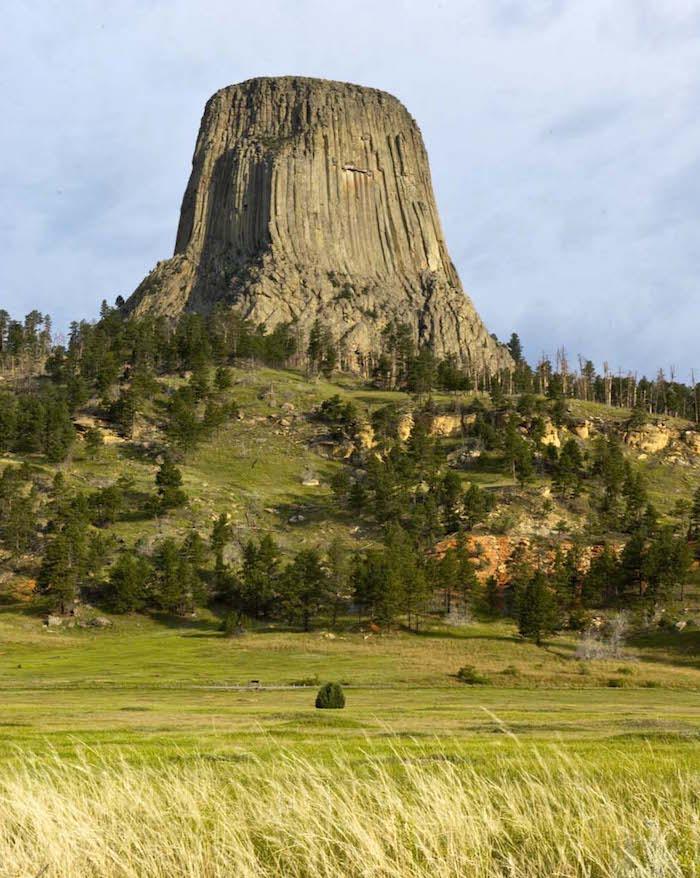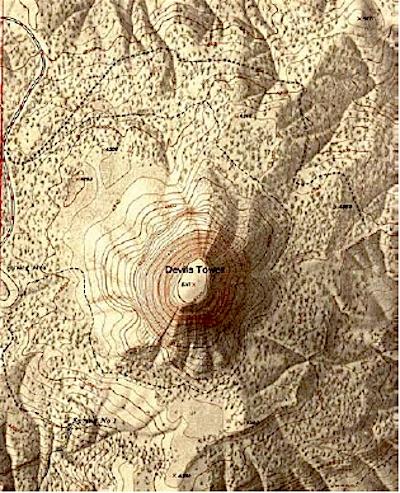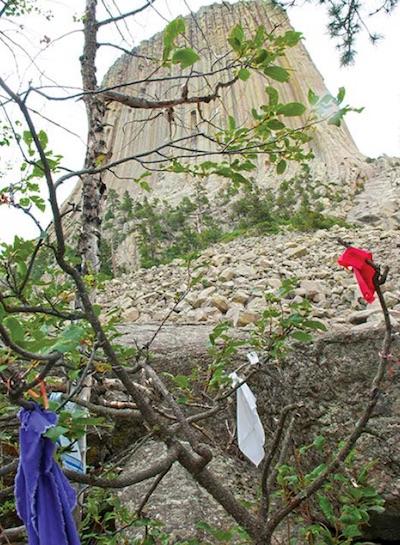
Devils Tower has a devilish name/Patrick Cone
Our forefathers were fiendish, hellish, you might even say devilish. Need proof? Look at the maps and the names of many of the places we visit. And then ask yourself, “Why in the Hell are so many places in our Western national parks named after the infernal demon, and his lair?”
You would think that the spiritual would overrule the demonic, based on the early settlers’ religious bent, but hundreds of hellish names are written large across our landscape, making it seem like a literal Hell on Earth. There are Hell Gates, Hell Holes, and Hell’s Half-acres. There are Devils Slides, Devils Playgrounds, Devils Postpile, Devils Golf Courses, and Diablo Canyons. Yellowstone National Park is rife with these names.
The Western landscape is harsh, dry, and rugged, so maybe it’s appropriate that the broad deserts, sweeping plains, jagged peaks, strange earth forms, and unearthly chasms have been given these labels. And they’re not even all in English. While Native American nations traditionally don’t have a literal “Devil” figure as we know it, there are spiritual names in their landscape. The early invading Spanish left a large legacy of places with Diablo and Inferna names, and even the French got into the game with Purgatoire.

A USGS map of Devils Tower/USGS
But by far, most of these topographical names are in English, seeing as how they largely were bestowed by the settlers, pioneers, and conquerors in the region. Author Wallace Stegner summed it up when he wrote that, “the Devil had a good deal to do with the making of the West, if we may believe the West’s place names.”
Take for example Devils Tower National Monument in northeastern Wyoming. You won’t find a more unusual landmark anywhere with its flat top, striated basalt sides, and its prominence rising above the grassy plains. It rivals any manmade ancient temple.
American author Scott Momaday understood that this was a unique geologic feature, a remnant of the interior of a 30-million-year-old volcano whose soft surrounding strata had worn away, when he described it at first sight:
“A dark mist lay over the Black Hills, and the land was like iron. At the top of the ridge I caught sight of Devils Tower up thrust against the gray sky as if in the birth of time the core of the earth had broken through its crust and the motion of the world was begun. There are things in nature that engender an awful quiet in the heart of man: Devils Tower is one of them.”
Devils Tower is truly an unexpected, and astounding, sight, which is why it graces all Wyoming license plates. It looms 1,200 feet above the redrock banks of the Belle Fourche River, and its acre-size summit is the ultimate altar, long revered as a sacred place by Native Americans such as the Lakota Sioux. It also draws some half-million visitors and has been known to even attract alien invaders, as depicted in the 1977 Steven Spielberg film, Close Encounters of the Third Kind.
But Devils Tower means different things to different people. Amid the pop cans and candy wrappers near the base you might find medicine bundles, tobacco, and twigs wrapped in torn pieces of colorful bandanas hanging from tree limbs. These are the sacred offerings of the Lakota Sioux, Crow, and other tribes. High above the bundles, Lycra-clad rock climbers pick their way up via the crack systems on the six-sided rock columns, their orange ropes spreading like spider webs across the lichen-covered cliffs. Down below, howling Harley riders, their T-shirts expletively-enhanced, arrive in vast herds on their way to the Sturgis, South Dakota, motorcycle rally. It’s truly a conflicted space.
Even the name Devils Tower is in dispute, and represents a classic clash of cultures. In 1875, Lieutenant Colonel Richard Irving Dodge, along with his subordinate, George Armstrong Custer, described the tower, and affixed the name to maps, though it was so labeled on an 1812 map as Devils Mountain by mountain man James Dougherty. Later, in 1906, President Theodore Roosevelt proclaimed Devils Tower as our premier national monument, for the protection of native artifacts and archaeological sites.
Devils Postpile National Monument in California is just one of the many places in the National Park System with a devilish name / Kurt Repanshek
But before Europeans came on the scene, it was known by many different names by the Arapaho, Crow, Lakota, Cheyenne, Kiowa, and Shoshone. Some 20 native tribes have cultural and spiritual connections with Devils Tower, but only five of those have actual geographic and historic connections. The Lakota, for example, believe that their own 3,000-year-old emergence site lies not far away in the Black Hills in today’s Wind Cave National Park. To them the tower is a place for renewal, where they pray to their gods, but not to the tower.
And they all had their own names for it, too. The Kiowa called it T’sou’a’e (Aloft on a Rock). The Mandan called it Tso-I-E, or Rock Tree (the tower’s similarity to a broken tree stump is striking). But Bears Lodge is the most common indigenous name: Mato Tipil’a in Lakota.
Native Big-Man described how Kills- Coming-To-The-Birds (who lived to be 117) remembered worshipping at Bears Lodge as far back as The Year the Stars Fell, in 1833. While no written language existed, picture stories painted on skins did depict the yearly events of the tribes. These pictorial calendars, or winter counts, recorded the Plains Indians’ history annually on prepared skins, and the Bears Lodge appears on these skins.

There is a Kiowa legend that Devils Tower rose up from the ground to save seven maidens from a bear, whose claws created the striations in the rock / NPS
According to the Kiowa, T’sou’a’e got its name when a bear chased seven girls as they played away from their village. As the bear drew close, the girls jumped up on a low rock and prayed, “Rock, take pity on us, Rock, save us.” The rock pushed the children high, out of reach of the bear, who frantically clawed at the stone, leaving the gouges and scratches on the rock.
But these natives were soon overwhelmed by gold miners, ranchers, and soldiers, and their name was swept away and replaced. Dodge’s geologist, Henry Newton, wrote that the landmark, “was recently known among the Indians as ‘the bad god’s tower,’ or, in better English, ‘the Devil’s tower...” The Sioux had no word for Devil, or Hades. So, a place for spiritual renewal has become a landmark to the Dark Lord.
Whatever the name’s origins, the name change did not please the Plains Indians. In a 1997 New York Times interview, Eastern Shoshone Diana Mitchell said, “To name it Devils Tower is a slap in the face because of what the whites used to call Indians back then: they were Devils, dirty Devils.”
She added, “Who wants to pray at something called Devils Tower?”

Medicine bundles and colorful clothes are left beneath tower by Native Americans as sacred offerings / Patrick Cone
So as not to intrude on sacred tribal gatherings, the National Park Service limits climbs up the tower during the month of June, when tribes gather during summer solstice for their Sun Dance. And some tribal members would like to see the name revert to Mato Tipil’a once again, or perhaps have a dual designation. But this would take an act of Congress, and there is little support locally for such a change.
To counter the push for change, U.S. Rep. Barbara Cubin of Wyoming introduced a bill in the 109th Congress to retain the name of Devils Tower. In her remarks of January 7, 1997, she stated that she had, “…received a petition with an estimated 2,000 names from not only those in and around the monument, but from all over (Crook) county.”
More recently, in early 2018, Rep. Liz Cheney, R-Wyoming, introduced similar legislation.
And some conflict between worshippers and casual visitors still continues. Some visitors are unfamiliar with the Tower’s importance to native cultures and have even desecrated the medicine bundles.
What is one person’s playground is another’s chapel. So, for now, this black, basalt tower’s name depends upon whom you talk to. What its real name is, however, no one knows.
DEVILISH
NAMES IN THE PARKS
• Big (and Little) Devils Stairs, Shenandoah National Park
• Big Kill Devil Hill, Wright Brothers National Memorial
• Bumpass Hell, Lassen Volcanic National Park
• Devil Canyon, Bighorn Canyon National Recreation Area
• Devils Cornfield, Death Valley National Park
• Devil’s Creek Canyon, North Cascades National Park
• Devil’s Den, Big Bend National Park
• Devil’s Den, Gettysburg National Military Park
• Devil’s Den, Yellowstone National Park
• Devil’s Dream Camp, Mount Rainier National Park
• Devil’s Elbow, Padre Island National Seashore
• Devils Garden, Blue Ridge Parkway
• Devils Garden, Arches National Park
• Devil’s Gate, Yellowstone National Park
• Devils Golf Course, Death Valley National Park
• Devil’s Hall Trail, Guadalupe Mountains National Park
• Devils Hole, Death Valley National Park
• Devils Island, Apostle Islands National Lakeshore
• Devils Kitchen, Lassen Volcanic National Park
• Devil’s Kitchen, Yellowstone National Park
• Devils Kitchen Trail, Colorado National Monument
• Devils Lookout, Wind Cave National Park
• Devils Orchard, Craters of the Moon National Monument and Preserve
• Devil’s Playground, Petrified Forest National Park
• Devils Postpile National Monument, California
• Devil’s Stairway, Yellowstone National Park
• Devil’s Throat Trail, Hawai’i Volcanoes National Park
• Devil’s Thumb, Yellowstone National Park
• Hellroaring Creek, Yellowstone National Park
• Hell’s Gate, Death Valley National Park



Comments
There is also a Devil's Hole just past Niagara Falls on the Niagara River in between both a New York State park and an Ontario, Canada park. A huge eddy there, and many tragic happenings, gave it the name.
Why should we be honoring the devil like that? We need to take back our parks by giving them wholesome names.
there's also a Devil's punch bowl on the Oregon coast .
Relax, folks. It is just a curiosity that such a christian myth is used so extensively. There are many other myth systems that yield names also.
Hell's Half Acre West if Casper
I think it mostly has to do with the harsh, dry, and sometimes excessively hot temperatures in many areas of the west
Remember that most of the white explorers were traveling under conditons constant danger and deprivation. When they named these strange, possibly threatening places, they were not having a good day. . .
the 'badlands' is another name for that terrain.